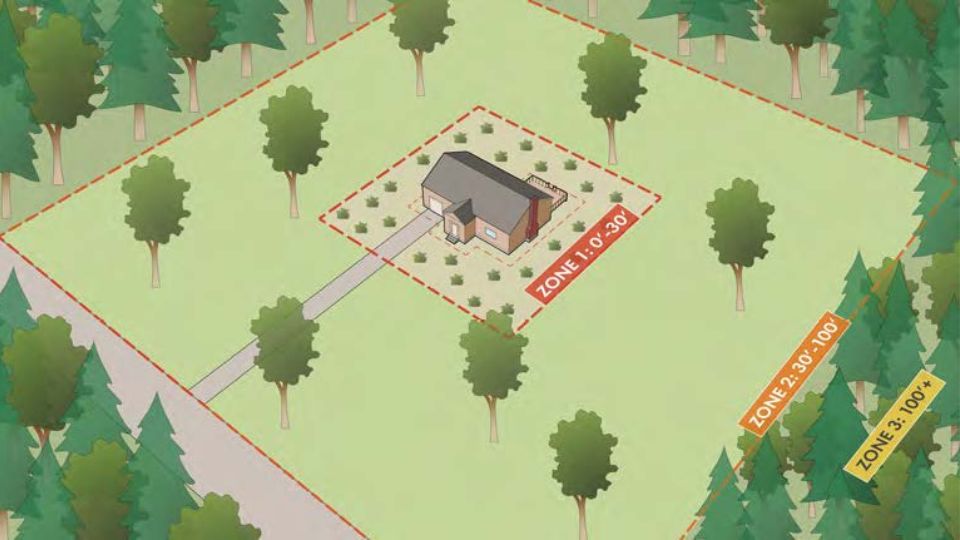Landscaping in the Utah Wildland-Urban Interface

What Is the Wildland-Urban Interface?
The wildland-urban interface (WUI) is simply where human development mingles with wildland, or in other words, developed land next to undeveloped land. This area is at the highest risk for damage from wildfire. Much of the WUI in Utah is in the foothills above our city centers (Figure 1). As our communities continue to grow outward, the WUI is only expanding, putting more people at risk from wildfire.
Why Does the Utah WUI Need Special Landscaping?

Protective, Low-Water, and Have Good Comfort
and Aesthetics
Because the WUI has such high wildfire risk, it is important for homes built there to have fire-protective landscaping. Also, because Utah is a desert state currently in a drought, low-water landscaping is important for all Utah landscapes, including the WUI. So, ideal landscaping for homes at the Utah WUI will be fire-protective and low-water (Figure 2). This will help protect from home loss due to wildfire and save precious water.
Fire-Protective Landscaping
Defensible Space
The first and most important principle of fire-protective landscaping is defensible space. The main idea of defensible space is to reduce the amount and continuity of flammable materials between the wildland and the home. A
good defensible space has three zones (Figure 3), each with their own requirements.

Zone 1: The Home and Zero Feet to 30 Feet Around the Home
- The home exterior should be made of nonflammable materials like stucco, concrete, and asphalt shingles.
- There should not be anything flammable next to, on, or within 5 feet of the house. This could include trees and shrubs against the house, stacked firewood, or pine needles on the roof.
- Firewood and propane tanks should not be stored next to the house.
- Zone 1 should be sparsely planted with low-growing plants.
- Make sure to give plants in Zone 1 enough water so that they are healthy and don’t dry out.
Zone 2: Between 30 Feet to 100 Feet Away From the Home
- Zone 2 should be kept relatively free of fuel, with few trees and shrubs.
- Planting should be in sparse, small clumps, not in large patches.
- Trees should have their lower branches removed so that fire cannot travel from lower vegetation into the trees. Space trees out with at least 20 feet between canopies to prevent fire from spreading between them.
- Turfgrass, paved areas, and sparse planting areas are ideal for Zone 2.
- If you have a propane tank, place it in Zone 2, and have a 10-foot area surrounding it with no flammable materials (including plants).
- The important thing to remember about Zone 2 is that it is creating a firebreak between the wildland and the home. The goal is to break the continuity of fuel so that it stops or slows down fire moving from the wildland to the home.
Fire-Resistant Materials
Even once your home is protected by defensible space, it is important to use fire-protective exterior materials. Fire can travel not only by igniting adjacent fuels but by lofted embers. This means that even if a wildfire cannot move through your defensible space, if a bit of flaming debris lands on a flammable part of your house, it can still catch on fire. To reduce the risk of this happening, avoid wood and other flammable materials. There are fire-resistant alternatives for nearly all home materials.
Roofing

Alternative to Wood Shingles (right)
Cedar shake or other wood shingles may have a rustic charm, but they are highly flammable (Figure 4). Asphalt shingles are a more fire-protective option. Tile and metal roofs are usually best but may be more expensive. Any roofing material used should be rated Class A, meaning it is the most fire-resistant.
Decks and Other Structures
Instead of a wood deck, consider having a paver or concrete area for outdoor dining and entertaining. Avoid decking made of composite wood materials like Trex, which actually burns hotter and longer than wood. Sheds, greenhouses, or any other structures adjacent to the house need to be considered.
Siding
Try to use materials like stucco, brick, concrete, or stone. Concrete board is a less flammable alternative to wood siding. Vinyl siding is not as flammable as wood, but it will melt in the event of a fire. There are flame-retardant coatings available for when wood siding or other wood construction cannot be replaced.
Fire-Resistant Plants
While all plants can burn, some plants are more flammable than others. Generally, avoid conifers, which are trees and shrubs with needles, such as pines, spruces, firs, and junipers. Because of flammable compounds in most conifer needles, they ignite more quickly. Broadleaf trees, such as maples, oaks, ash, lindens, and many others are better options for trees. Smaller varieties are better because they provide less fuel. Make sure to not plant trees that drop more seeds, leaves, and branches than you are willing to regularly clean up. Trees should have their branches trimmed away from the ground and the house. Some plants are more resistant than average to fire because of fire-retardant compounds in them, higher water content, and other factors (Figure 5).
Low-Water Landscaping

and Fire-Resistant Plant
Aside from wildfire, one of the biggest concerns for landscaping in Utah is water conservation. The way that you landscape your yard can make a big difference in how much water you use.
Low-Water Plants
One of the biggest ways to reduce water use while still having a nice landscape is to use plants that don’t require as much water. Some plants require much more water than others to do well. Luckily, low-water plants are becoming more available at local greenhouses and garden centers. You can often tell if a plant has low water needs by its tag at the greenhouse, or by looking it up online on websites like Missouri Botanical Garden and Monrovia.
Drip Irrigation
Conventional spray irrigation can be an effective way to water large areas, but it can be very wasteful. Much of the water is lost to the wind, or ends up watering areas without plants (and ends up watering weeds instead). Using drip irrigation can save water by delivering only needed water amounts. Like a standard spray system, a valve is turned on and pressurized water fills the system. Then, instead of being sprayed through the air by spay heads, the water is distributed through smaller tubes and eventually released through emitters. Drip emitters are designed to let out a certain amount of gallons per hour, so they can be customized for how much water your plants need.
Often, if you already have spray irrigation installed, you can use a kit to convert an old sprinkler head to drip tubing.
Spray Irrigation
For areas that are better irrigated by traditional irrigation, such as lawns, there are sprinkler head options that use less water. Rotator style heads are often a good option for using less water.
Turfgrass Use
Turfgrass, sometimes called lawn grass or just “grass,” can be a wonderful element in a home landscape. However, since turfgrass has such high water needs, in our arid climate, it is important to consider how it is used.
In many landscapes, grass is the default land cover—if nothing else is there, just put grass. A better way to decide where to put grass is to consider what the grass will be used for and put the amount that is needed for that activity. For example, if you hope to use your lawn for throwing a football with kids, then you might decide that a 40 foot by 20 foot area is how much you need for that activity. The rest of the area that would be lawn can become something else that uses less water.
Putting It All Together
Both fire-protective and low-water landscaping require many considerations, but in most situations, it is possible to do both (Figure 6). Also, in addition to creating a fire-protective and low-water landscape, you will probably want it designed in a style you like, be low maintenance, and used for what you like to do in your yard, whether that’s entertaining or playing with your dog.
Ideally, your landscape will fall in the center of the Venn diagram shown in Figure 2. However, sometimes it is not possible or practical for every aspect of your landscape to be ideal in all three categories. In those situations, it is up to you to decide which category is the most important to you.
If what you need and want from your landscape is too complex for you to design on your own, it may be worth hiring a professional landscape designer or landscape architect.
Want to Learn More?
If you’re interested in learning more about choosing the best landscaping for your home in the WUI, you can take the interactive Landscaping in the Wildland-Urban Interface course offered through Utah State University (USU) Extension at: https://extensioncourses.usu.edu/
You can also visit the USU Extension websites on wildfire and water conservation:
- Emergency Preparedness: https://extension.usu.edu/preparedness/wildfires
- Water-Wise Landscape Design: https://extension.usu.edu/laep/water-wise
Other helpful resources include:
- Localscapes program: https://localscapes.com/
- Landscape Architecture and Environmental Planning: https://extension.usu.edu/laep/#item-3

Note. Low-water plants are spaced apart, and limited turfgrass and fire-resistant building materials are used. Less ideal features include the flammable wood mulch and shrubs against the house.
References
- Cohen, J. (2003, May). Preventing residential fire disasters during wildfires. In WARM International Workshop (p. 190).
- Hilaire, R. S., Arnold, M. A., Wilkerson, D. C., Devitt, D. A., Hurd, B. H., Lesikar, B. J., Lohr, V. I., Martin, C. A., McDonald, G. V., Morris, R. L., Pittenger, D. R., Shaw, D. A., & Zoldoske, D. F. (2008). Efficient water use in residential urban landscapes. HortScience, 43(7), 2081–2092. https://doi.org/10.21273/HORTSCI.43.7.2081
- Inskeep, B. D., & Attari, S. Z. (2014). The water short list: The most effective actions U.S. households can take to curb water use. Environment: Science and Policy for Sustainable Development, 56(4), 4–15. https://doi.org/10.1080/00139157.2014.922375
- Kuhns, M., & Daniels, B. (2012). Firewise landscaping for Utah. Utah State University Extension. https://www.slc.gov/fire/wp-content/uploads/sites/47/2019/04/FirewiseLandscaping2012.pdf
- Radeloff, V. C., Helmers, D. P., Kramer, H. A., Mockrin, M. H., Alexandre, P. M., Bar Massada, A., Butsic, V., Hawbaker, T. J., Martinuzzi, S., & Syphard, A. D. (2018). Rapid growth of the U.S. wildland-urban interface raises wildfire risk. In Proceedings of the National Academy of Sciences, 115(13), 3314–3319.
Published March 2023
Utah State University Extension
Peer-reviewed fact sheet
Authors
Jordan Goff, David Anderson, Jake Powell, and Darren McAvoy


 Utah 4-H & Youth
Utah 4-H & Youth

